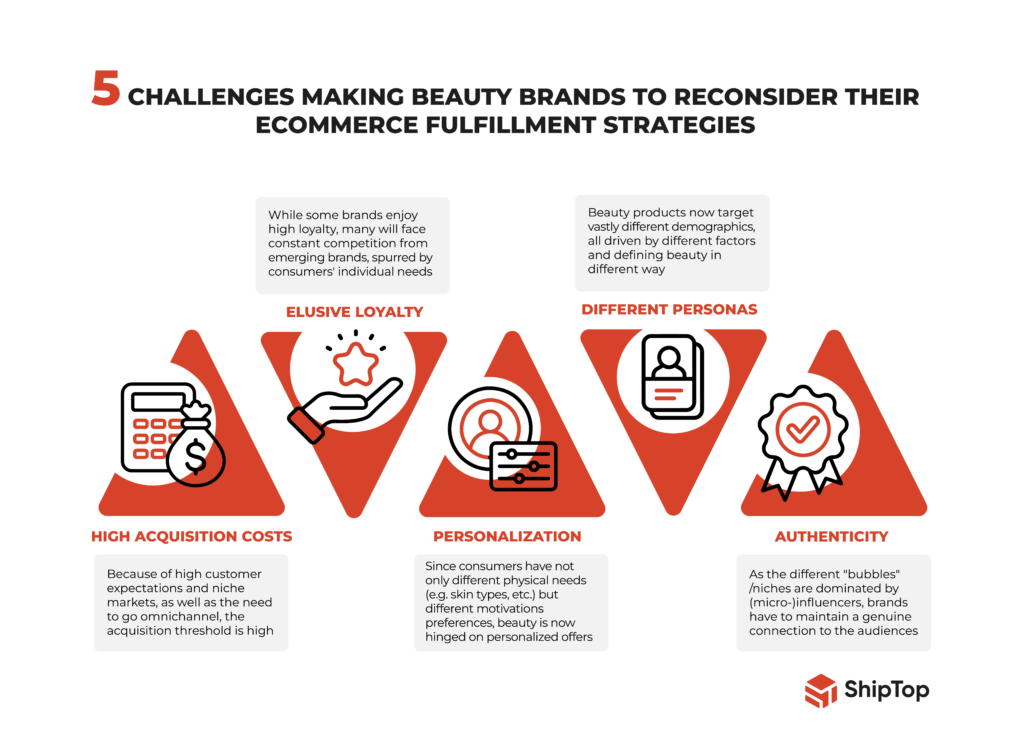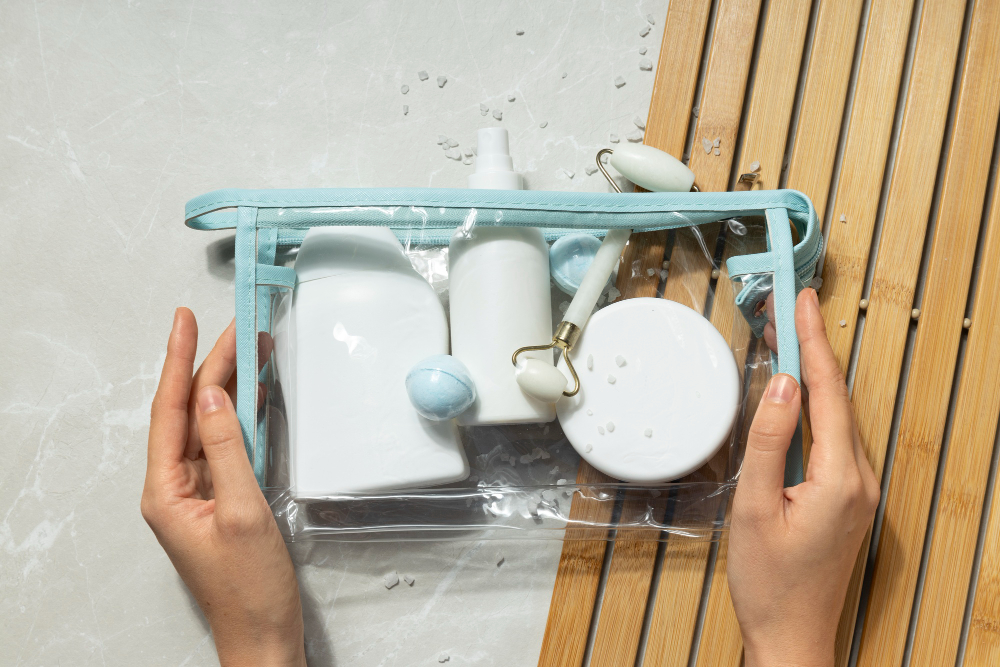The current state of cosmetics and beauty brands deserves an entire book, and eCommerce fulfillment would be a long chapter. Lipsticks, serums, and eyeshadow palettes are now just a click away from the consumer, but here’s the thing: customers are getting pickier and crave not just things but also experiences. They want their orders fast – we’re talking same-day or next-day fast – all wrapped in a bow of personalized pampering.
But behind these seamless experiences lies a complex web of fulfillment challenges: inventory prediction, speedy yet sustainable delivery, global shipping rules, and product preservation across climates. Given the trend-driven nature of beauty and cosmetics, these complexities are particularly demanding, compounded by the need to handle delicate products, Instagram-worthy packaging, and efficiently process a high volume of small, varied orders to cater to individual preferences and trends.
So, what can a beauty brand do in this tricky environment? First and foremost, be aware of the latest fulfillment trends and optimized strategies they inspire; this is what can help beauty brands deliver at lower costs, and with higher customer satisfaction.
Why Beauty Brands Are Rethinking Their eCommerce Strategies
According to a McKinsey report, the global beauty market is expected to reach $580 billion by 2027, and eCommerce is going to play a huge role in driving that growth. However, this also means increased competition and a fair share of challenges that are forcing beauty brands to reconsider their online strategies.
One of the major issues brands face, according to reports by Monks, McKinsey and multiple other resources, is the escalating cost of customer acquisition. And despite great investments to attract potential buyers, retaining their loyalty is yet a big challenge as 52% of consumers are now more willing to experiment with new products in pursuit of the better offer.
And it’s not just about getting customers to recognize the value per se: authenticity becomes a critical success factor for beauty brands. As many as 90% of shoppers emphasize that authenticity influences their brand choices. In terms of fulfillment it means reliable service, transparent communication, and delivering on promises: retaining the “face” of the brand that the influencers and micro-influencers have created, all the way to the moment the package is delivered.
Another major factor is that consumer expectations also evolve with many seeking experiences that replicate the in-store interactions they are accustomed to. One point that proves that is that 77% of consumers are likely to make purchases via social commerce platforms that excel at real-time interaction with sellers, instant feedback on products, mimicking the in-store experience. However, the rise of platforms like Instagram and TikTok adds another layer of complexity to beauty fulfillment, causing unpredictable spikes in demand and requiring agile supply chains to respond to viral trends.
Speaking of customer preferences, some prefer personalized and authentic experiences, while others are driven by social media trends. Simply put, customers are different, and this creates the challenge of using agile and connected strategies like omnichannel fulfillment to cater to every individual one. Of course, going omnichannel can be hard, particularly due to the need for seamless integration between online and in-store experiences, all the while the branding has to stay consistent, inventory needs to be managed across multiple channels, and customer service quality at every touchpoint is still a major piece of the puzzle.

Any of these challenges alone would be reasons enough for beauty brands to look for innovative approaches in eCommerce fulfillment. And there many interesting takes on the matter, too: personalized subscription boxes, CX-oriented technology like virtual try-ons and live chat support, and seamless returns process – all of them can (and do) significantly enhance customer satisfaction and retention.
eCommerce Fulfillment Trends Shaping Beauty Brands’ 2024 Strategies
If we are to describe eCommerce fulfillment in general as of 2024, it is mostly about automation, sustainability, and personal touches. These elements are, in fact, interconnected and crucial for various aspects of fulfillment. For instance, automation helps with things like same-day delivery, which can increase conversion rates by 20-30%. Personalization tactics, such as custom packaging, can lead 52% of consumers to make repeat purchases if the packaging exceeds their expectations.
Let’s give these trends a more detailed breakdown they deserve:
#1 Personalized beauty buying experience for customers
Accenture has found 91% of consumers are more likely to shop with brands that provide personalized offers and recommendations. In terms of fulfillment, personalization translates to a myriad of adjustments like custom packaging, personalized messages, and tailored delivery options, all designed to enhance the customer experience.
Beauty brands can keep up with these trends by adding personal touches to how they handle orders. This might mean using customer data to create custom packaging, adding personalized thank-you notes, and suggesting products based on what customers have bought before. This makes shopping more fun and satisfying. Plus, they could offer eco-friendly packaging for those who prefer sustainable options.
Another aspect is that brands can also make delivery routines more flexible. They could let you pick delivery times that work for you or send tracking updates with your name and what you bought.
#2 Social Selling
Thanks to social media platforms like Instagram, Facebook, and TikTok, brands can connect directly with consumers, not just gaining insights, but actively offering personalized recommendations and exclusive deals in real-time.
However, fulfilling orders in the realm of social selling poses its own unique challenges. Social media selling is essentially based on momentary instincts, and while modern algorithms allow to remind the consumer they’ve been interested in a specific item, it’s not helpful if the order fulfillment goes askew: the customer will just subconsciously categorize the entire brand as “irrelevant” and a blight on the timeline. Additionally, viral trends can lead to sudden surges in demand, necessitating real-time inventory tracking. In this way, social media sets high standards for unique, personalized packaging.
💡 ShipTop’s response: We approach this challenge by means of superior inventory management, as well as packing routines. With proper inventory management and predictive analytics, we can allow the brand to have as many items of a specific product sent to an intermediate location as necessary, without the risk of chronic shortages, but with adequate packaging.
#3 Sustainable packaging initiatives
With 74% of consumers willing to pay more for sustainable packaging, some beauty brands are eager to adapt. In practice, this means using biodegradable materials, opting for simpler, minimalistic designs to cut down on waste, and coming up with creative recycling programs. Some brands are even looking at reusable packaging to make an even bigger impact on reducing environmental waste.
What does that mean for fulfillment, though? The short answer is that brands need to rethink their supply chains, ensure the new packaging materials are durable enough for shipping, and, of course, sustainability can incur higher costs that are to be mitigated with higher efficiency somewhere along the line.
💡 ShipTop’s response: We offer options for plastic-free fulfillment. Our fulfillment centers are equipped with machines for water-activated tapes, which contain no plastic, further supporting sustainability efforts. These initiatives not only enhance brand reputation but also contribute to significant cost savings and operational efficiencies in the long run.
Read more: How ShipTop Is Reducing the Environmental Impact of eCommerce
#4 Cross-border logistics
eCommerce has inherited one of the main advantages of the internet as such in the eyes of the consumer – namely that it’s international in essence. Small wonder, then, that efficient cross-border logistics is a requirement. This, in turn, has its own fair share of influence on what order fulfillment looks like. The overall “equation” now has several more variables, like regulations, tariffs, and customs requirements, all of them leaving an impact on the final price and time of delivery.
💡ShipTop’s response: Our expertise in overseas regulations, customs brokerage services, and up-to-date tracking systems ensure that your products reach customers worldwide on time and cost-effectively.
#5 Omnichannel Fulfillment
73% of retail consumers are omnichannel shoppers.This essentially refers to the fact that not only is shopping done both in-store and online these days, but there are different options in between, as well.
The latter broad category being labeled “hybrid shopping”, this also poses a challenge for fulfillment. Keeping track of inventory across multiple platforms can be tricky, sometimes leading to stock issues. Logistics get more complicated and expensive as brands try to fulfill orders quickly from various sources. Plus, staying consistent in branding, packaging, and customer service across all these channels is tough but crucial.
#6 Loyalty programs
Beauty brands are better off in terms of customer loyalty than, say, food and beverage, simply because in most cases once the consumer has chosen a brand they will want replenishments of the existing products. Once people find a product they love, they usually stick with it and keep buying it. This makes them more likely to join loyalty programs to get extra perks. Big retailers like Sephora and Ulta Beauty are great examples. They’ve been running successful loyalty programs for years, offering things like free samples, discounts, and early access to sales. Ulta does especially well, with 95% of its sales coming from their Ultimate Rewards program, which has over 40 million members.
However, handling these additional perks involves more labor and organization. These brands have to make sure samples are included in shipments, manage the inventory carefully, and ensure everything reaches customers on time.
That has become our strategic course at ShipTop as we connect all customer sales channels into one system, simplifying inventory management and speeding up order fulfillment. Our platform lets customers effortlessly manage orders and track inventory in real-time. Plus, we ensure quick and reliable deliveries through top carriers like UPS and FedEx.
How 3PL Commerce Fulfillment Can Help Beauty Brands Succeed
60% of online retailers outsource a portion of their fulfillment services. This is quite a logical way to tap into the expertise of companies that specialize in storing, packing, and shipping products and focus on what they do best: creating amazing products and marketing them effectively.
Here are some key factors of how professional order fulfillment can support beauty and cosmetics brands.
Appropriate Storage
Storage is, in many ways, the base level of ensuring proper fulfillment for beauty brands – after all, we are talking of fragile and easily spoiled products in many cases. Numerous types of beauty products have specific storage requirements, such as temperature control and humidity levels, to ensure they don’t spoil or degrade.
Professional order fulfillment companies like ShipTop can precisely address these needs by providing temperature-controlled warehouses to store sensitive products like lotions, serums, and cosmetics. Additionally, fulfillment companies implement advanced inventory management systems, ensuring that products are well-organized, easy to locate, and within their shelf-life, which helps maintain their quality until they reach the customer.
Personalized Packaging
The unboxing experience has become a crucial aspect of the customer journey, especially in the beauty industry. Personalized packaging can enhance this experience and leave a lasting impression on the consumer.
eCommerce fulfillment providers can make this happen for beauty brands, providing packaging options and specifications according to a given individual’s choice or campaign/media specific packaging. Because of their sophisticated equipment and experience, they can accommodate different requests concerning the type of box and the inserts as well.
💡One of the key advantages of working with ShipTop is that we offer customizable fulfillment solutions. This means we can use your custom packaging, include your promotional inserts and flyers, and add branded tissue paper and inserts to each package.
Predictable Delivery
According to Statista, global online shoppers expect beauty product deliveries, on average, within 1-2 days. Real-time tracking and partnering with reliable shipping services help meet these expectations. However, handling this in-house can be difficult due to the complexities of inventory management, technology needs, and maintaining multiple shipping relationships.
💡 ShipTop makes shipping easy by working with top carriers like UPS, Canada Post, USPS, FedEx, and DHL. With a 99.8% accuracy rate and 98.6% of orders shipped on time, you can count on your customers always getting their orders when they expect them.
Returns Management
The return management aspect is considered as one of the main factors that make the shopping experience effective. In the beauty industry, returns happen about 5% of the time.
Returned products need careful checks to determine if they can be resold, repurposed, or must be disposed of. Opened items usually can’t be resold for safety reasons. Plus, managing the specifics of storage, quality checks, and safe handling requires specialized infrastructure and resources.
💡 These tasks are time-consuming and require detailed attention, making it hard for brands to manage alone. So, fulfillment centers like ShipTop ensure efficient returns management as a part of their services offerings to allow brands to focus on what they do best. For return management, we offer features like real-time tracking and pre-printed return labels, and we have a dedicated team for standardized inspections and efficient restocking.
Automation Capabilities and Efficiencies
Automation makes eCommerce simple and fast. With the help of modern technologies, fulfillment centers can quickly process orders, update stock in real-time, and use robots for accurate picking. It may also help to make shipping smarter with real-time tracking that keeps customers updated. Plus, data analytics may be used to show what’s selling well.
Managing all this tech can be tough and time-consuming. So, it is another aspect that makes cooperation with fulfillment partners a better option. Often, they offer advanced automation tools that beauty brands may not have.
💡 ShipTop also brings a lot of automation to the eCommerce fulfillment process. Our all-in-one platform handles everything from connecting your store and managing inventory in real-time to automating order processing and shipping.
Omnichannel Connectivity of Different Social Touchpoints
Online stores, marketplaces, and physical shops – all these channels involve syncing data from all those sources to keep track of inventory and orders in one place.
For beauty brands, this is vital because the majority of customers buy products from various channels and still expect quick, accurate deliveries. But it’s tough to manage all that data and tech on your own. It requires advanced software, constant monitoring, and seamless integration, which can be time-consuming and expensive.
💡 ShipTop make omnichannel fulfillment more manageable, integrating eCommerce platforms and marketplaces within one easy-to-use platform, so all sales channels work seamlessly together. This helps to keep track of inventory in real-time, handle order processing, and ensure fast shipping. Our integration list includes Shopify, Magento, BigCommerce, WooCommerce, Amazon, Walmart, TikTok Shop, Google Shopping, eBay, and Etsy.
Final Thoughts
Almost half of the growth in retail sales for health, beauty, and personal care products is driven by eCommerce. But selling beauty products online creates its own set of challenges for beauty eCommerce fulfillment.
- Online sales are booming, so brands must handle many more orders than before.
- Customers often want personalized beauty products, like custom shades or skincare routines. The same applies to packaging.
- Consumers are increasingly environmentally conscious and prefer sustainable packaging.
- Shoppers expect quick delivery times, similar to what they’ve experienced with giants like Amazon.
- Ensuring rapid fulfillment while maintaining accuracy and quality.
- Beauty products often involve personal preferences, making returns and exchanges more common.
Managing this in-house can be really tough and expensive because it requires a lot of resources, like warehouses, staff, and technology. There are just a few reasons why beauty brands prefer to use services of a trusted cosmetics fulfillment partner like ShipTop.
- We offer specialized cosmetics fulfillment services tailored to beauty products’ unique needs.
- This includes same-day order processing for quick delivery, expert SKU management to track inventory, and customized packaging to protect and enhance your brand.
- Supporting the FIFO method, we ensure products with earlier manufacturing or expiration dates are shipped first, maintaining your reputation and customer trust.
You can contact us for a quote and a consultation on how exactly we can streamline and safeguard your brand’s eCommerce fulfillment at any time.






